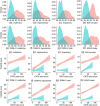Adverse childhood experiences exacerbate peripheral symptoms of autism spectrum disorder in adults
- PMID: 39037014
- PMCID: PMC11804926
- DOI: 10.1111/pcn.13712
Adverse childhood experiences exacerbate peripheral symptoms of autism spectrum disorder in adults
Abstract
Aim: Adverse childhood experiences are potentially traumatic events with long-lasting effects on the health and well-being of patients with autism spectrum disorder (ASD). It is important to clarify which types of long-lasting autism-related symptoms are influenced by childhood experiences to design future intervention studies. However, few studies have examined the association between childhood experiences and autistic symptoms in large samples of adults with ASD and individuals with typical development (TD). In this study, we evaluate the effects of adverse childhood experiences on multiple ASD phenotypes among both individuals with ASD and those with TD.
Method: We combined questionnaire evaluations; Childhood Abuse and Trauma Scale, the Japanese version of the Autism-Spectrum Quotient, Conners' Adult ADHD Rating Scale, the Japanese version of the Impact of Event Scale-Revised, and the Japanese version of the Adolescent/Adult Sensory Profile.
Results: Individuals with ASD and those with TD (n = 205 and 104, respectively) were included. There were significant correlations between the extent of adverse childhood experiences and severity of attention-deficit/hyperactivity disorder symptoms, posttraumatic stress disorder symptoms, and hypersensitivity in both participants with ASD and those with TD. By contrast, ASD core symptoms showed no significant correlation with adverse childhood experiences in either group. These results remained consistent after adjusting for age, sex, and the estimated intelligence quotient.
Conclusion: These findings suggest the need for a detailed disentanglement of ASD-related core and peripheral symptoms of adverse childhood experiences, which may help to appropriately set outcomes for future early interventions for the childhood experiences of individuals with ASD.
Keywords: adverse childhood experiences; attention‐deficit/hyperactivity disorder; autism spectrum disorder; sensory hypersensitivity.
© 2024 The Author(s). Psychiatry and Clinical Neurosciences published by John Wiley & Sons Australia, Ltd on behalf of Japanese Society of Psychiatry and Neurology.
Figures




References
-
- Felitti VJ, Anda RF, Nordenberg D et al. Relationship of childhood abuse and household dysfunction to many of the leading causes of death in adults. The adverse childhood experiences (ACE) study. Am. J. Prev. Med. 1998; 14: 245–258. - PubMed
-
- Fujiwara T. Impact of adverse childhood experience on physical and mental health: A life‐course epidemiology perspective. Psychiatry Clin. Neurosci. 2022; 76: 544–551. - PubMed
-
- Petruccelli K, Davis J, Berman T. Adverse childhood experiences and associated health outcomes: A systematic review and meta‐analysis. Child Abuse Negl. 2019; 97: 104127. - PubMed
MeSH terms
Grants and funding
- 23H04173/Japan Society for the Promotion of Science
- 24K02386/Japan Society for the Promotion of Science
- 21gm6310015h0002/Japan Agency for Medical Research and Development
- 21uk1024002h0002/Japan Agency for Medical Research and Development
- 21wm04250XXs0101/Japan Agency for Medical Research and Development
LinkOut - more resources
Full Text Sources
Medical

